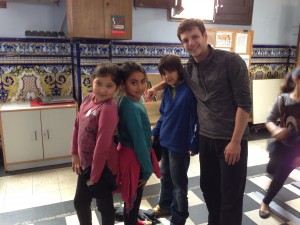[simple_slideshow]
Hubbard Street Dance Chicago is known for taking choreographic risks. From bringing top European choreographers like Mats Ek to the Chicago stage to commissioning works from emerging artists to cultivating in-house talent with danc(e)volve: New Works Festival 2013. Some risks are bigger than others. Some pay off, while some get chalked up to a learning experience. This “risk” showcased in the two-week run of performances at the MCA Stage, pays off big time. Usually, there is one piece that sticks with you, one that stands out – a favorite. Not here, all six new works are sharp, unique and satisfying.
The choreographers range from the more experienced – HS2 director Terence Marling, former Hubbard Street dancer Robyn Mineko Williams and soon-to-depart, new Mom Penny Saunders to the younger, just-starting-out HS2’s Andrew Wright. Wright proves he has a bright future as a choreographer opening the show with Agape. Utilizing his fellow HS2-ers, he goes from a twitchy opening female solo with dancers running and reaching for something unattainable to a freeing second section where the dancers run in abandon with their arms and heads flung back. The second company commands the stage in this opening piece, especially Emile Leriche, who will join the main company this fall. She’s strong, subtle and stunning. When she’s on stage, you simply can’t take your eyes off her. At times, she seems to dissipate like a puff of smoke.
With a packed touring schedule, we rarely get to see HS2 perform alongside the main company. It was nice to see the younger dancers mixed in with the more seasoned dancers. Marling’s ditto, a trio with HS2’s Leriche and Brandon Lee Alley dancing with Ana Lopez, blurred the lines between first and second company. Alley showed considerable skill partnering the always stunning Lopez. Saunders’ Adalea featuring six dancers from the main company had some fun with chairs, ending with a tumbling, tossing, physical duet with Jesse Bechard and Johnny McMillan. As a lovely extra, at the end of the first act, a video made by the dancers of their trip with DanceMotion USA was shown giving us a glimpse into some of the adventures they had while in North Africa and Spain. Pictures and video from the trip with voice over from the dancers reveal an inspiring once-in-a-lifetime adventure.
Jonathan Fredrickson’s Límon-esque For the Wandered was a meditation in white for five dancers incorporating text via hidden microphones inside movable starched white mounds of material. Most of the new works were somber, focusing on the complex construction and the dancing, but Marling’s stop…stop…stop. was a lighter, humorous romp set to a mambo with the dancer’s voices remixed on top like an audio thought bubble. HS2’s Lissa Smith and Richard Walters were perfect as a shy, awkward potential couple manipulated by the dashing Quinn B Wharton as a mentor/matchmaker. Wharton’s intermittent sly solos a fun, quirky interlude to the actions of the couple. Mineko William’s Grey Horses closed the show with the black brick back wall exposed creating a darker, starker stage. Again mixing dancers from both companies (props to Leriche – again – and Walters!), she used the stark setting to create another dance of shadows across the back wall with beautiful solo work by Alice Klock. Set to music titled Ghost Come Morning by Robert G. Haynes, the final image of Klock and her shadow fading in to the dark brought an otherworldly feel.
Most performances are already sold out, but there are ticket still available for the Sunday, June 16 shows. Get them here now!
Slideshow Photo Captions: All photography by Todd Rosenberg.
Emilie Leriche and Felicia McBride in “Agape” by Andrew Wright.
Brandon Lee Alley and Emilie Leriche in “ditto” by Terence Marling.
Quinn B Wharton and Jessica Tong in “Adalea” by Penny Saunders.
Johnny McMillan and Jesse Bechard in “Adalea” by Penny Saunders.
Alice Klock and Johnny McMillan in “For the Wandered” by Jonathan Fredrickson.
Richard Walters and LIssa Smith in “stop…stop…stop.” by Terence Marling.
Garrett Anderson and Alice Klock in “Grey Horses” by Robyn Mineko Williams.


